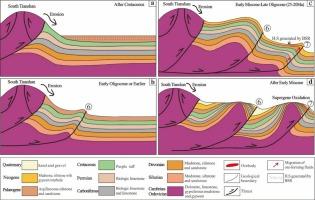Geological, geochemical and geochronological characteristics of the Jiashi sandstone-hosted Cu deposit in the Kalpin fold-thrust belt in front of South Tianshan Orogen and their implications
IF 3.6
2区 地球科学
Q1 GEOLOGY
引用次数: 0
Abstract
The fold-thrust belts in front of the South Tianshan Orogen host numerous sandstone-hosted copper deposits and occurrences within Meso-Cenozoic continental red beds. The Jiashi Cu deposit (>2 Mt ore @ 1.2 % Cu in proven reserves) is particularly noteworthy among these sandstone-hosted Cu deposits, and orebodies are hosted in continental sandstone of the Paleogene sedimentary sequences. The copper mineralization at Jiashi is characterized by disseminated, veined, stripped and massive sulfides, which are predominantly composed of chalcocite with minor bornite and chalcopyrite. Chalcocite is inferred to have a hydrothermal origin based on its primary sulfide characteristics, similar compositions of major elements, and analogous δ34Sv-CDT values (−33.34 ‰ ∼ −35.78 ‰) for chalcocite grains from core to rim, although the copper mineralization is superimposed by later supergene oxidation. Eight chalcocite samples were dated using Re-Os isotopic method, yielding an isochron age of 21.2 ± 3.6 Ma, which was regarded as the mineralization age. It is slightly younger than the ore-bearing sandstone of the Paleogene sequences (23.4 ∼ 38 Ma), indicating an epigenetic origin. Based on these geological characteristics and the new mineralization age, we propose that significant sandstone-hosted copper mineralization occurred during the Early Miocene at Jiashi, formed in an intracontinental orogenic environment with coupling of thrust activation and large-scale fluid migration. These findings indicate that the fold-thrust belts in front of the South Tianshan Orogen possess considerable potential for the discovery of additional large-scale sandstone-hosted copper deposits.

南天山造山带前卡尔平褶皱冲断带加石砂岩型铜矿床地质、地球化学和年代学特征及其意义
南天山造山带前的褶皱冲断带在中新生代陆相红层内赋存大量砂岩型铜矿床和产状。在这些砂岩型铜矿床中,嘉石铜矿(探明储量为2 Mt,含铜量为1.2%)尤为引人注目,其矿体赋存于古近系沉积层序的陆相砂岩中。嘉石铜矿成矿特征为浸染状、脉状、条状和块状硫化物,硫化物以辉铜矿为主,少量含斑铜矿和黄铜矿。根据黄铜矿的原生硫化物特征、主要元素组成特征和黄铜矿从岩心到岩缘的δ34Sv-CDT值(- 33.34‰~ - 35.78‰)相似,推测黄铜矿为热液成因,但铜成矿作用是后期表生氧化作用的叠加。用Re-Os同位素法测定了8个辉石样品的等时年龄(21.2±3.6 Ma),认为这是成矿年龄。它比古近系含矿砂岩(23.4 ~ 38 Ma)略年轻,为表成成因。基于这些地质特征和新的成矿时代,我们认为早中新世嘉石地区发生了显著的砂岩型铜矿成矿作用,形成于逆冲活动和大规模流体运移耦合的陆内造山环境。这些发现表明,南天山造山带前的褶皱冲断带具有发现大型砂岩型铜矿床的潜力。
本文章由计算机程序翻译,如有差异,请以英文原文为准。
求助全文
约1分钟内获得全文
求助全文
来源期刊

Ore Geology Reviews
地学-地质学
CiteScore
6.50
自引率
27.30%
发文量
546
审稿时长
22.9 weeks
期刊介绍:
Ore Geology Reviews aims to familiarize all earth scientists with recent advances in a number of interconnected disciplines related to the study of, and search for, ore deposits. The reviews range from brief to longer contributions, but the journal preferentially publishes manuscripts that fill the niche between the commonly shorter journal articles and the comprehensive book coverages, and thus has a special appeal to many authors and readers.
 求助内容:
求助内容: 应助结果提醒方式:
应助结果提醒方式:


